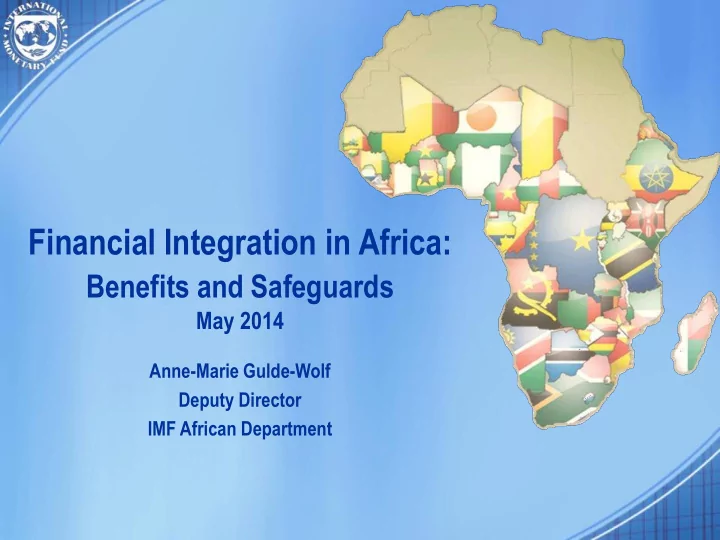

Financial Integration in Africa: Benefits and Safeguards May 2014 Anne-Marie Gulde-Wolf Deputy Director IMF African Department
Global and regional financial integration can be beneficial. Global integration: The region needs to safely use foreign saving . SSA needs significantly more private and public capital (infrastructure) than it can afford with its own saving. SSA faces significant demands to provide for health and education of a rapidly growing working-age population. Returns on human and physical capital could be high and foreign investment could be mutually beneficial, especially from countries with wealthy aging populations. Regional integration: Larger markets, more efficient allocation of capital. Most SSA markets are small, with little competition, and limited economies of scale. Pooling saving and insurance premiums allow a better allocation of risk and scarce financial resources. Managerial capacity in the continent remains low. 2
But financial integration needs to be done right. A safe and sound financial integration that avoids financial crises, excessive risk taking, fraud, and macroeconomic disruptions, requires: Macroeconomic policy frameworks that are resilient to capital flow movements. Prudential systems that can properly manage the cross border risks at the institutional and system wide level. Resolution systems at the institution and systemic level that can contain the damage in case of stress. Financial integration in Africa poses more challenges than traditional cross border relations with European banks. 3
Financial integration: Global actors remain important Banking groups from Europe and the region operate in many SSA countries. British Bank Groups, 2005 British Bank Groups, 2012 Nigerian Bank Groups, 2005 Nigerian Bank Groups, 2012 South African Bank Groups, 2005 South African Bank Groups, 2012 French Bank Groups, 2005 French Bank Groups, 2012 4
Financial integration: French Banks Relevant, but declining footprint 5
Financial integration: Market based integration resulting from the rapid expansion of Pan-African banks while some of the Pan-African banking groups are expanding rapidly. Standard Bank, 2005 Standard Bank, 2012 Ecobank, 2005 Ecobank, 2012 Bank of Africa, 2005 Bank of Africa, 2012 Attijariwafa Bank, 2005 Attijariwafa Bank, 2012 6
Is sub-Saharan Africa prepared for financial integration? Making progress, but not quite there yet. Macroeconomic policy frameworks have improved but are not fully resilient to capital flows. Limited capital account liberalization ; Capital controls remain prevalent in a large number of countries. Fixed exchange rate regimes helped control inflation, but may be more vulnerable to capital flow changes. Monetary regimes often weak. Countries with flexible exchange rate regimes still strengthening monetary policy frameworks. Fiscal buffers in home countries insufficient for large regional expansion 7
Financial integration has outpaced improvements in prudential arrangements and macroeconomic policy frameworks: Some of these banking groups are systemically important in the region, especially Ecobank, Standard Bank, Barclasy, and Bank of Africa. Systemically Important Subsidiaries (Number of subsidiaries with deposit share exceeding 10 percent of the banking system deposits) 14 12 10 8 6 4 2 0 8 Sources: Annual Reports, BankScope, and IMF staff estimates.
Inadequate cross border consolidated supervision in the face of prevalent cross border banking activity is risky Cross-border coordination and information sharing between home and host supervisors needs to improve. 100 100 Overall Observance with Basel Core Principles Cross Border 80 80 60 60 Percent Percent 40 40 20 20 0 0 Asia and Emerging Middle Latin Africa Advanced Asia and Emerging Middle Latin Africa Advanced Pacific Europe East America Countries Pacific Europe East America Countries 9
What needs to be done to draw the full benefits from financial integration in sub-Saharan Africa? Continue to build more resilient macroeconomic policy frameworks and adequate buffers to withstand greater capital mobility. Improve cross border consolidated supervision. Review crisis management, put in place resolution frameworks for a systemic cross border bank. In the meantime, financial and capital account liberalization need to be carefully sequenced. 10
How can the Banque de France help? Setting an example in cross border supervision by: Better coordination and information sharing with SSA supervisors. tailoring sub-Sahara specific meetings of the supervisory colleges of French banks operating in SSA. Keep contributing staff for technical assistance in the areas of strengthening macroeconomic frameworks and prudential regulation and supervision. 11
THANK YOU! 12
Recommend
More recommend